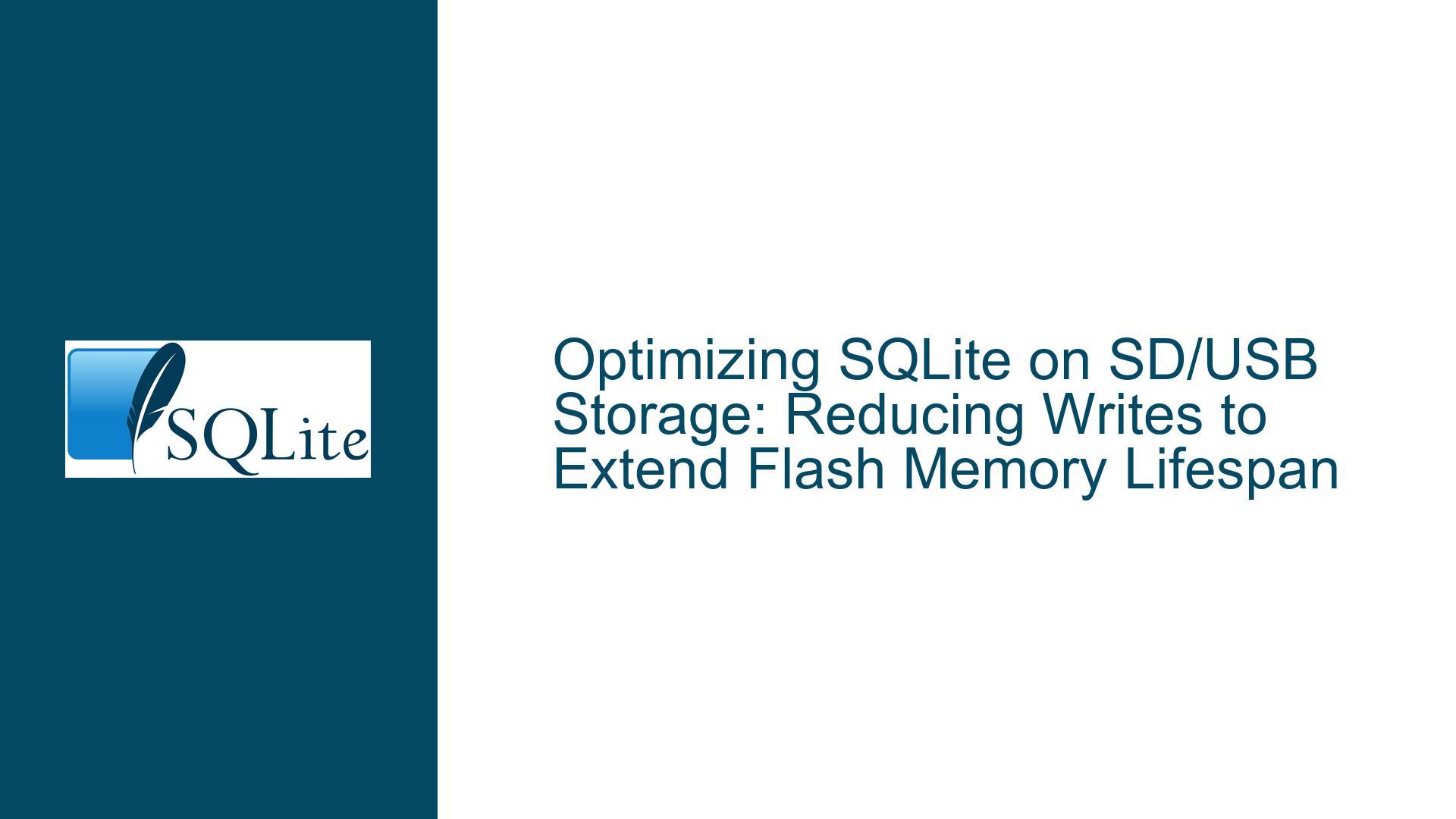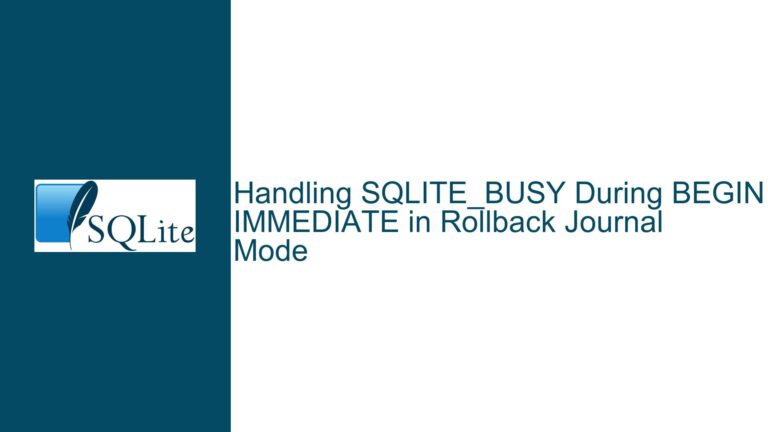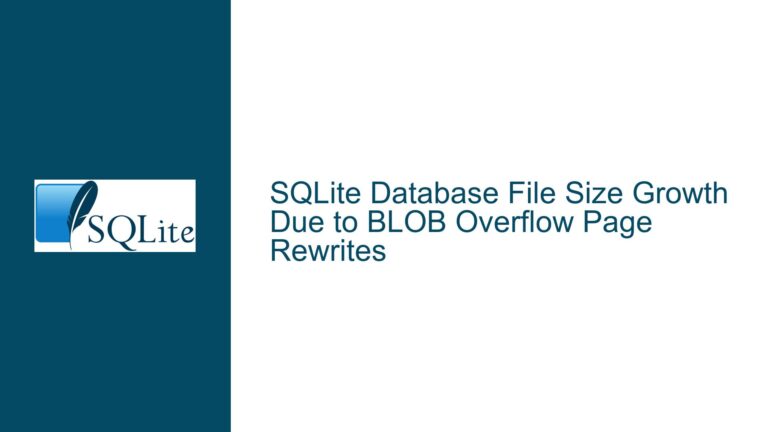Optimizing SQLite on SD/USB Storage: Reducing Writes to Extend Flash Memory Lifespan
Understanding Flash Memory Constraints and SQLite Write Behavior
Flash-based storage devices such as SD cards and USB memory sticks have inherent limitations due to their finite program-erase (P/E) cycles. A typical NAND flash cell supports between 1,000 (TLC/QLC) and 100,000 (SLC) write operations before wear-induced failure. SQLite databases interacting with these devices face unique challenges because every COMMIT operation triggers multiple low-level storage events:
Journal File Operations: In default rollback journal mode (DELETE), SQLite creates a rollback journal before modifying the main database. This involves:
- Writing journal header (28 bytes)
- Flushing entire database pages to be modified into the journal
- Syncing the journal to stable storage
- Updating the main database file
- Deleting the journal
Page-Level Writes: SQLite operates with fixed-size pages (default 4KB). A single row update may require rewriting the entire containing page, adjacent pages during overflow, and associated index pages. Write amplification ratios of 5-20x are common.
Metadata Updates: File system operations (e.g., extending the database file, updating inode timestamps) create additional writes. The Linux ext4 file system alone generates ~16 metadata writes per 4KB database page update.
Temporary Storage: Queries involving sorting, subqueries, or complex joins generate temporary tables. With PRAGMA temp_store=FILE (default), these create transient writes to the same physical medium.
The compounding effect of these factors means a logical "INSERT INTO logs VALUES(…)" could manifest as 50+ NAND cell writes. A device rated for 3,000 P/E cycles handling 100 transactions/day would theoretically last just 300 days before reaching wear limits – an unacceptable lifespan for embedded deployments.
Critical Factors Accelerating Flash Wear in SQLite Deployments
Transaction Granularity and Journaling Modes
Frequent small transactions maximize journal file operations. Consider a logging application committing each event individually:
BEGIN IMMEDIATE;
INSERT INTO sensor_data VALUES(CURRENT_TIMESTAMP, 22.5);
COMMIT;
This sequence generates:
- Journal header write (28B)
- Database page write (4KB)
- Journal deletion (metadata update)
Total: ~8KB actual NAND writes per event
Accumulating 50 events in a single transaction reduces this to:
- One journal header
- Batched page updates (possibly contiguous)
- Single journal deletion
Total: ~12KB writes for 50 events (76x reduction)
Page Size Mismatch
SQLite’s default 4KB page size often misaligns with flash memory’s physical 16KB-256KB erase block sizes. A 4KB database page update forces the flash controller to:
- Read entire erase block containing the page (e.g., 128KB)
- Modify the 4KB segment
- Erase the entire 128KB block
- Write back modified block
This converts a 4KB logical write into 128KB physical writes – 32x amplification.
Vacuum and Auto-Vacuum Operations
VACUUM and AUTO_VACUUM=INCREMENTAL/FULL rewrite entire database files to defragment space. A 1GB database undergoing daily VACUUM would endure 1GB * 365 = 365GB/year writes – sufficient to exhaust consumer-grade flash in under 6 months.
Filesystem Metadata Overhead
Common Linux mount options like relatime (default since kernel 2.6.30) update file access timestamps on every read. For a database file queried frequently:
$ mount | grep /mnt/usb
/dev/sda1 on /mnt/usb type ext4 (rw,relatime)
Each SELECT triggers an inode timestamp update, adding 3-5 metadata writes per query. Mounting with noatime/nodiratime disables this:
mount -o remount,noatime,nodiratime /mnt/usb
Comprehensive Optimization Strategies for Flash-Based SQLite
1. Transaction Batching with Deferred Locking
Group logical writes using explicit transactions spanning multiple operations. Prefer DEFERRED transactions over IMMEDIATE/EXCLUSIVE when possible:
MAX_BATCH_SIZE = 50 # Events per transaction
batch_count = 0
def log_event(cursor, event):
global batch_count
if batch_count == 0:
cursor.execute("BEGIN DEFERRED")
cursor.execute("INSERT INTO logs VALUES (?, ?)", (event.time, event.data))
batch_count += 1
if batch_count >= MAX_BATCH_SIZE:
cursor.execute("COMMIT")
batch_count = 0
# Periodically commit remaining events
def flush_events(cursor):
if batch_count > 0:
cursor.execute("COMMIT")
batch_count = 0
Key Considerations:
- DEFERRED allows concurrent readers but delays lock acquisition
- Batch size should align with flash erase block size (e.g., 64 events @ 512B/event = 32KB batch)
- Use WAL mode if concurrent reads are needed during writes
2. Journal Mode and Synchronization Tuning
PRAGMA journal_mode = MEMORY; -- Keep journal in RAM (riskier)
PRAGMA synchronous = NORMAL; -- Balance safety vs. writes
Alternative: WAL Mode with Aggressive Checkpointing
PRAGMA journal_mode = WAL;
PRAGMA wal_autocheckpoint = 1000; -- Pages in WAL before auto-checkpoint
WAL Tradeoffs:
- Reduces fsync() calls compared to DELETE journal
- Checkpointing merges WAL into main DB file (large sequential write)
- Requires periodic wal_checkpoint(PASSIVE) during idle periods
3. Page Size Alignment
Determine flash device erase block size (e.g., 128KB) using flash_erase --info /dev/sdb. Set SQLite page size to match:
PRAGMA page_size = 131072; -- 128KB pages
VACUUM; -- Rebuilds database with new page size
Validation:
PRAGMA page_size; -- Verify after VACUUM
4. In-Memory Database with Periodic Flushing
For append-only workloads:
sqlite3_open(":memory:", &mem_db);
sqlite3_exec(mem_db, "ATTACH 'file:/mnt/usb/backup.db?cache=shared' AS disk", 0,0);
// Every 60 seconds
sqlite3_exec(mem_db, "BEGIN IMMEDIATE");
sqlite3_exec(mem_db, "INSERT INTO disk.logs SELECT * FROM main.logs", 0,0);
sqlite3_exec(mem_db, "DELETE FROM main.logs", 0,0);
sqlite3_exec(mem_db, "COMMIT");
Crash Safety:
- Use UPS with safe shutdown hooks
- Maintain write-ahead log on disk for in-memory changes
5. Avoiding VACUUM Through Smart Pruning
Instead of periodic VACUUM, maintain rolling window:
-- Keep last 30 days of data
DELETE FROM sensor_data
WHERE timestamp < strftime('%s','now','-30 days');
-- Reuse free pages immediately
INSERT INTO sensor_data VALUES (...);
Enable auto_vacuum=INCREMENTAL if deletions are frequent:
PRAGMA auto_vacuum = INCREMENTAL;
PRAGMA incremental_vacuum(100); -- Free 100 pages after delete
6. Monitoring Actual Writes with VFS Shim
Compile and load the SQLite VFS statistics module:
wget https://sqlite.org/src/raw/ext/misc/vfsstat.c?name=ext/misc/vfsstat.c
gcc -g -fPIC -shared vfsstat.c -o vfsstat.so
In application:
sqlite3_vfs_register(sqlite3_vfs_find("vfsstat"), 1);
Query write counts:
SELECT * FROM vfsstat WHERE name LIKE '%/mnt/usb/db%';
Output Interpretation:
vfs | writes | bytes
----------------------------------------
/dev/sdb| 1523 | 1245184
Monitor write patterns under load to identify optimization opportunities.
7. Filesystem and Mount Options Optimization
Configure /etc/fstab for flash storage:
/dev/sda1 /mnt/usb ext4 noatime,nodiratime,data=writeback,commit=300 0 0
Option Breakdown:
- noatime/nodiratime: Disable access time updates
- data=writeback: Don’t journal file data (metadata only)
- commit=300: Sync data every 5 minutes (riskier)
- discard: Enable TRIM for wear-leveling (requires SSD support)
8. Write-Avoidance Schema Design
A. Event Binning
CREATE TABLE sensor_bins (
bin_start INTEGER PRIMARY KEY,
count INTEGER DEFAULT 0,
sum REAL DEFAULT 0.0
);
-- Instead of 1000 individual inserts
UPDATE sensor_bins
SET count = count + 1, sum = sum + ?
WHERE bin_start = 1717027200; -- Hourly bins
B. Append-Only Logs with Preallocation
-- Preallocate 1GB file with 100MB reserved space
PRAGMA auto_vacuum = OFF;
PRAGMA page_size = 131072;
PRAGMA mmap_size = 1073741824; -- 1GB RAM mapping
9. Hardware-Aware Configuration Management
Detect storage parameters at runtime:
import os
import sqlite3
def configure_db(path):
conn = sqlite3.connect(path)
cursor = conn.cursor()
# Query block size (Linux)
dev = os.stat(path).st_dev
with open(f"/sys/dev/block/{dev}/queue/physical_block_size", "r") as f:
block_size = int(f.read())
cursor.execute(f"PRAGMA page_size = {block_size}")
cursor.execute("VACUUM")
print(f"Configured page size to {block_size}")
10. Long-Term Monitoring and Alerting
Implement wear-level monitoring using SMART tools:
# Install smartmontools
sudo apt-get install smartmontools
# Monitor USB SSD wear
sudo smartctl -a /dev/sdb | grep Percentage_Used
Expected Output:
177 Wear_Leveling_Count 0x0013 099 099 000 Pre-fail Always - 99
179 Used_Rsvd_Blk_Cnt_Tot 0x0013 100 100 010 Pre-fail Always - 0
181 Program_Fail_Cnt_Total 0x0012 100 100 010 Old_age Always - 0
182 Erase_Fail_Count_Total 0x0012 100 100 010 Old_age Always - 0
Final Configuration Checklist
Transactions
- Batch writes ≥1MB per commit
- Use WAL mode with checkpoint throttling
Schema
- Avoid unnecessary indexes
- Use INTEGER PRIMARY KEY for rowid tables
- Preallocate storage with
PRAGMA mmap_size
Pragmas
PRAGMA journal_mode = WAL; PRAGMA synchronous = NORMAL; PRAGMA temp_store = MEMORY; PRAGMA mmap_size = 1073741824; -- 1GBFilesystem
- Mount with
noatime,nodiratime,discard - Allocate 10% free space for wear leveling
- Mount with
Hardware
- Use industrial-grade SLC SD cards
- Monitor SMART attributes monthly
By systematically applying these strategies, developers can extend SD/USB storage lifespan from months to decades, even in high-write embedded SQLite deployments. Actual optimization requires continuous monitoring using VFS statistics and SMART tools to balance write reduction against data integrity requirements.






